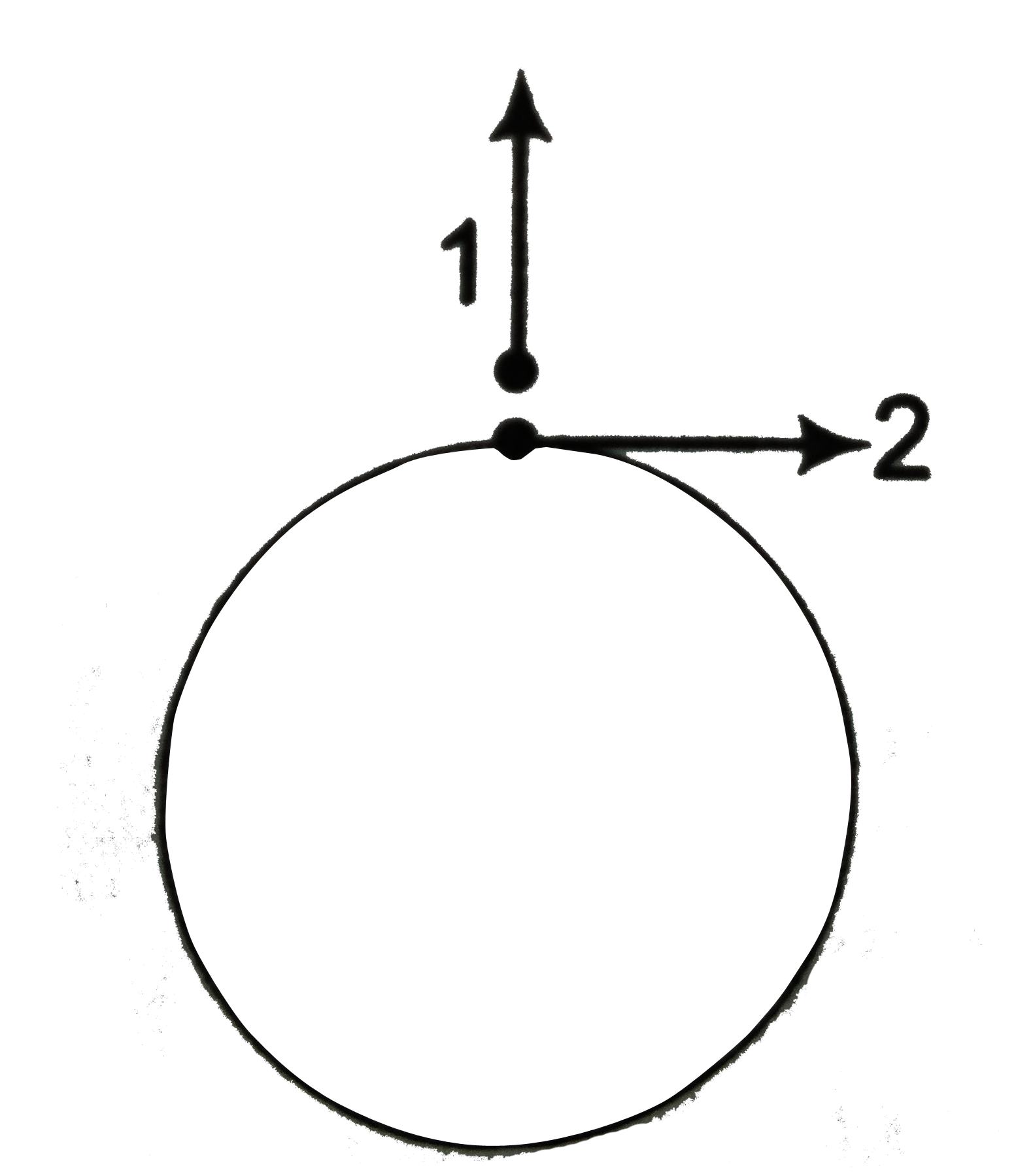Two particles are projected vertically upwards from the surface of the earth with velocities υ1=√2gR3andυ2=√4gR3 respectively. If the maximum heights attained by the two particles are h1 and h2 respectively, then calculate the ratio h1h2.
The correct Answer is:25
To solve the problem, we will use the principle of conservation of energy. The maximum height attained by a particle projected vertically upwards can be derived from the initial kinetic energy and the change in gravitational potential energy.
1. Identify the Given Values:
- For particle 1: v1=√2gR3
- For particle 2: v2=√4gR3
2. Use the Conservation of Energy:
The total mechanical energy (kinetic + potential) at the point of projection will equal the total mechanical energy at the maximum height.
For a particle projected upwards:
Initial Kinetic Energy=Final Potential Energy−Initial Potential Energy
12mv2=mgh+(−GMmR)
3. Calculate Maximum Height for Particle 1:
12mv21=mgh1+(−GMmR)
Substituting v1:
12m⎛⎝√2gR3⎞⎠2=mgh1−GMmR
Simplifying:
12m⋅2gR3=mgh1−GMmR
mgR3=mgh1−GMmR
Rearranging gives:
mgh1=mgR3+GMmR
Dividing by mg:
h1=R3+GMgR
4. Calculate Maximum Height for Particle 2:
12mv22=mgh2+(−GMmR)
Substituting v2:
12m⎛⎝√4gR3⎞⎠2=mgh2−GMmR
Simplifying:
12m⋅4gR3=mgh2−GMmR
2mgR3=mgh2−GMmR
Rearranging gives:
mgh2=2mgR3+GMmR
Dividing by mg:
h2=2R3+GMgR
5. Calculate the Ratio h1h2:
h1h2=(R3+GMgR)(2R3+GMgR)
Let x=GMgR:
h1h2=13+x23+x
Cross-multiplying gives:
=1+3x2+3x
As x approaches zero (for large R), this simplifies to:
12
6. Final Result:
Therefore, the ratio of the maximum heights attained by the two particles is:
h1h2=12
- For particle 1: v1=√2gR3
- For particle 2: v2=√4gR3
The total mechanical energy (kinetic + potential) at the point of projection will equal the total mechanical energy at the maximum height.
Initial Kinetic Energy=Final Potential Energy−Initial Potential Energy
12mv2=mgh+(−GMmR)
12mv21=mgh1+(−GMmR)
Substituting v1:
12m⎛⎝√2gR3⎞⎠2=mgh1−GMmR
Simplifying:
12m⋅2gR3=mgh1−GMmR
mgR3=mgh1−GMmR
Rearranging gives:
mgh1=mgR3+GMmR
Dividing by mg:
h1=R3+GMgR
12mv22=mgh2+(−GMmR)
Substituting v2:
12m⎛⎝√4gR3⎞⎠2=mgh2−GMmR
Simplifying:
12m⋅4gR3=mgh2−GMmR
2mgR3=mgh2−GMmR
Rearranging gives:
mgh2=2mgR3+GMmR
Dividing by mg:
h2=2R3+GMgR
h1h2=(R3+GMgR)(2R3+GMgR)
Let x=GMgR:
h1h2=13+x23+x
Cross-multiplying gives:
=1+3x2+3x
As x approaches zero (for large R), this simplifies to:
12
Therefore, the ratio of the maximum heights attained by the two particles is:
h1h2=12
Similar Questions
Three particles are projected vertically upward from a point on the surface of the earth with velocities √2gR/3 ,√gR,√4gR/3 surface of the earth. The maximum heights attained are respectively h1,h2,h3.
View SolutionA particle is projected vertically upwards the surface of the earth (radius Re) with a speed equal to one fourth of escape velocity what is the maximum height attained by it from the surface of the earth?
View Solution
Knowledge Check
Three particles are projected vertically upward from a point on the surface of earth with velocities
v1=√2gR3,v2√gR,v3√4gR3
respectively, where g is acceleation due to gravity on the surface of earth. If the maximum height attained are h1,h2 and h3 respectively, then h1:h2:h3 isA1:2:3B2:3:4C1:2:4D1:3:5
For statement of question 118, if the heights of the two images are h1 and h2 , respectively,then the height of the object (h) is
View SolutionTwo identical particles 1 and 2 are projected from surface of earth with same velocities in the directions shows in figure.

View SolutionA particle is projected vertically upwards with a velocity √gR, where R denotes the radius of the earth and g the acceleration due to gravity on the surface of the earth. Then the maximum height ascended by the particle is
View SolutionA particle is projected vertically upwards with a velocity √gR, where R denotes the radius of the earth and g the acceleration due to gravity on the surface of the earth. Then the maximum height ascended by the particle is
View SolutionA ball is projected upwards from a height h above the surface of the earth with velocity v. The time at which the ball strikes the ground is
View SolutionA ball is projected upwards from a height h above the surface of the earth with velocity v. The time at which the ball strikes the ground is
View SolutionA body is projected vertically upward from the surface of earth with a velocity sufficient to carry it to initially. Calculate the time taken by it to reach height h.
View Solution
